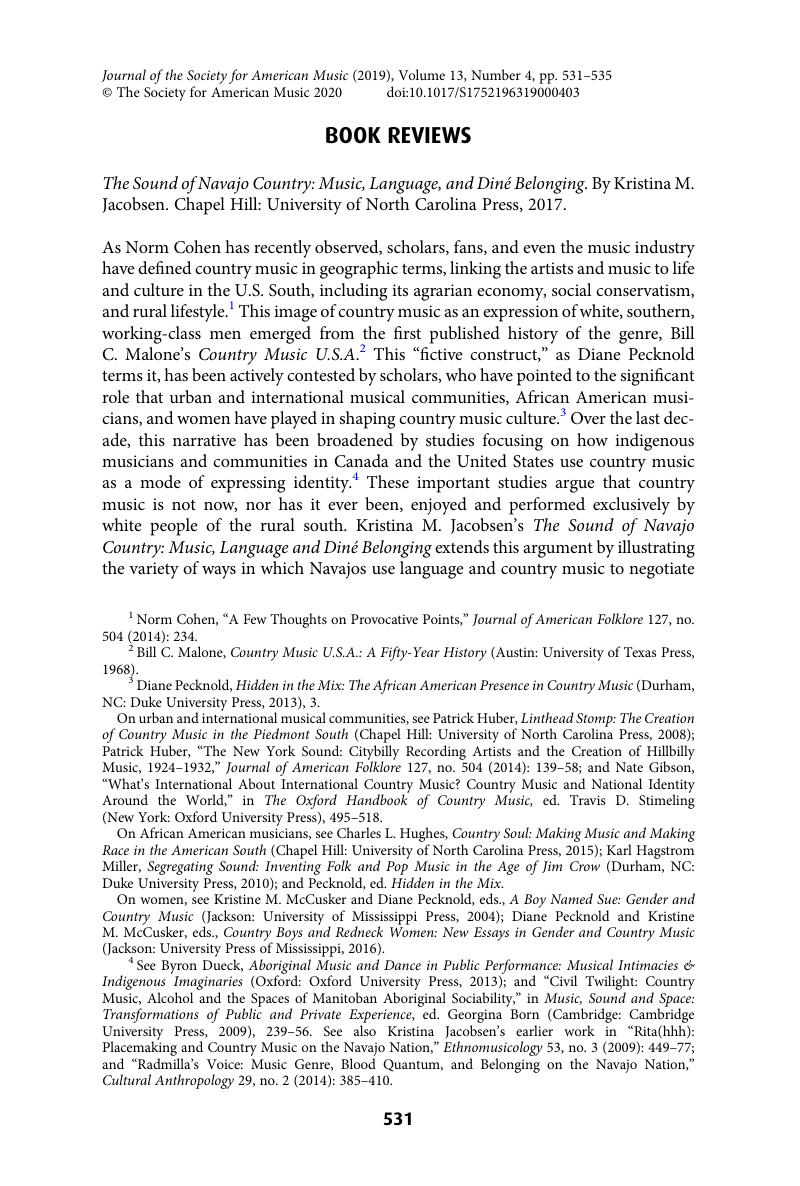No CrossRef data available.
Article contents
The Sound of Navajo Country: Music, Language, and Diné Belonging. By Kristina M. Jacobsen. Chapel Hill: University of North Carolina Press, 2017.
Published online by Cambridge University Press: 07 January 2020
Abstract

- Type
- Book Review
- Information
- Journal of the Society for American Music , Volume 13 , Special Issue 4: Music, Indigeneity, and Colonialism in the Americas , November 2019 , pp. 531 - 535
- Copyright
- Copyright © The Society for American Music 2020
References
1 Cohen, Norm, “A Few Thoughts on Provocative Points,” Journal of American Folklore 127, no. 504 (2014): 234CrossRefGoogle Scholar.
2 Malone, Bill C., Country Music U.S.A.: A Fifty-Year History (Austin: University of Texas Press, 1968)Google Scholar.
3 Pecknold, Diane, Hidden in the Mix: The African American Presence in Country Music (Durham, NC: Duke University Press, 2013), 3CrossRefGoogle Scholar.
On urban and international musical communities, see Huber, Patrick, Linthead Stomp: The Creation of Country Music in the Piedmont South (Chapel Hill: University of North Carolina Press, 2008)CrossRefGoogle Scholar; Huber, Patrick, “The New York Sound: Citybilly Recording Artists and the Creation of Hillbilly Music, 1924–1932,” Journal of American Folklore 127, no. 504 (2014): 139–58CrossRefGoogle Scholar; and Gibson, Nate, “What's International About International Country Music? Country Music and National Identity Around the World,” in The Oxford Handbook of Country Music, ed. Stimeling, Travis D. (New York: Oxford University Press), 495–518Google Scholar.
On African American musicians, see Hughes, Charles L., Country Soul: Making Music and Making Race in the American South (Chapel Hill: University of North Carolina Press, 2015)CrossRefGoogle Scholar; Miller, Karl Hagstrom, Segregating Sound: Inventing Folk and Pop Music in the Age of Jim Crow (Durham, NC: Duke University Press, 2010)CrossRefGoogle Scholar; and Pecknold, ed. Hidden in the Mix.
On women, see McCusker, Kristine M. and Pecknold, Diane, eds., A Boy Named Sue: Gender and Country Music (Jackson: University of Mississippi Press, 2004)Google Scholar; Pecknold, Diane and McCusker, Kristine M., eds., Country Boys and Redneck Women: New Essays in Gender and Country Music (Jackson: University Press of Mississippi, 2016)Google Scholar.
4 See Dueck, Byron, Aboriginal Music and Dance in Public Performance: Musical Intimacies & Indigenous Imaginaries (Oxford: Oxford University Press, 2013)CrossRefGoogle Scholar; and “Civil Twilight: Country Music, Alcohol and the Spaces of Manitoban Aboriginal Sociability,” in Music, Sound and Space: Transformations of Public and Private Experience, ed. Born, Georgina (Cambridge: Cambridge University Press, 2009), 239–56Google Scholar. See also Jacobsen's, Kristina earlier work in “Rita(hhh): Placemaking and Country Music on the Navajo Nation,” Ethnomusicology 53, no. 3 (2009): 449–77Google Scholar; and “Radmilla's Voice: Music Genre, Blood Quantum, and Belonging on the Navajo Nation,” Cultural Anthropology 29, no. 2 (2014): 385–410CrossRefGoogle Scholar.
5 Peterson, Richard, Creating Country Music: Fabricating Authenticity (Chicago: University of Chicago Press, 1997)CrossRefGoogle Scholar.
6 Jacobsen's book extends the narrative lens of existing scholarship that addresses rural iconography in country music, including Fox, Aaron, Real Country Music and Language in Working-Class Culture (Durham, NC: Duke University Press, 2004)CrossRefGoogle Scholar; Fox, Pamela, Natural Acts: Gender, Race, and Rusticity in Country Music Ann Arbor: University of Michigan Press, 2009)CrossRefGoogle Scholar; Lange, Jeffrey, Smile When You Call Me a Hillbilly: Country Music's Struggle for Respectability (Athens: University of Georgia Press, 2004)Google Scholar; McCusker, Kristine, Lonesome Cowgirls and Honky-Tonk Angels: The Women of Barn Dance Radio (Urbana: University of Illinois Press, 2008)Google Scholar; and Peterson, Creating Country Music.


